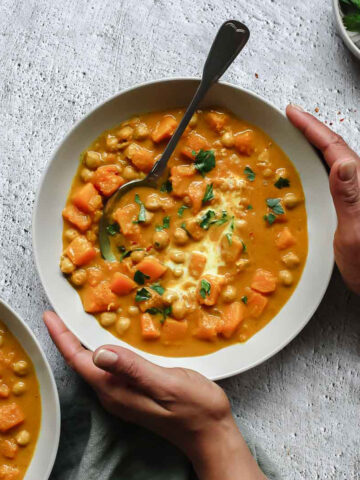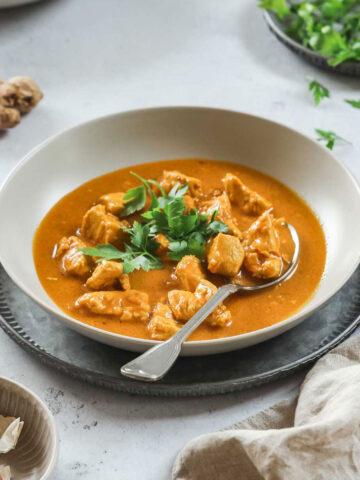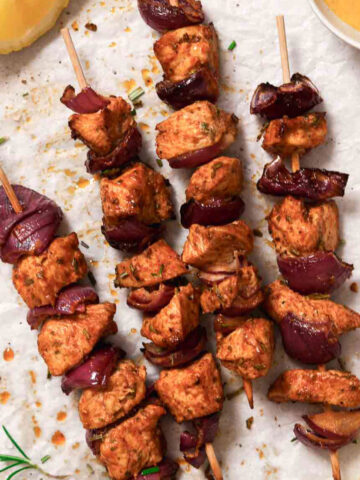This vegan Thai yellow vegetable curry delivers intense flavor and is made of good-for-you ingredients. The best part? The vibrant dish does without the addition of curry paste.

Looking for a flavorful and hearty vegetarian meal packed with all the flavor? Look no further than this delicious yellow vegetable curry. I created this vegan version of the yellow curry without adding store-bought curry paste.
Instead, the healthy vegetable curry uses spices you have at home to create a fragrant dish. With a rich and creamy coconut milk base, it is perfect when served over rice or salad on the side.
Jump to recipe
What is Thai yellow curry?
Thai yellow curry is a type of Thai curry that is usually made with a spicy and aromatic yellow curry paste. A yellow curry paste typically includes turmeric, coriander, cumin, chili, ginger, and garlic.
The paste is then simmered with coconut milk and vegetables, such as cauliflower, potatoes, zucchini, and bell peppers. In addition, non-vegan versions of the curry often contain a protein such as chicken, fish, or shrimp.
Yellow curry is milder in flavor and less spicy compared to other Thai curries, such as green or red curry.
Is yellow curry healthy for you?
This vegan Thai yellow vegetable curry is packed with a variety of nutrients. Vegetables are low-carb but flavorful ingredients with different vitamins and minerals. Moreover, yellow curry paste contains several spices that have potential health benefits. For example, turmeric holds a compound called curcumin, which has antioxidant and anti-inflammatory properties.
Other spices used in this yellow curry, such as cumin and coriander, have been shown to have digestive benefits, such as reducing bloating and improving gut health.

Why you’ll love this recipe
- bold flavors
- creamy texture
- good-for-you ingredients
- naturally plant-based
- one-pot-recipe
- ready in 35 minutes
Looking for more plant-based curries? Try this butternut squash curry, perfect when made in fall.
Ingredient notes

- Vegetables – Use fresh vegetables for the best flavor and texture. You can use other vegetables such as carrots, potatoes, or green beans in addition to the cauliflower, zucchini, and bell pepper.
- Ginger – I always use fresh ginger root for the best flavor. You can peel it using a spoon or a vegetable peeler, then grate it finely using a grater.
- Yellow curry powder – Curry is a blend of spices that usually includes turmeric, coriander, ginger, and cumin. You can find it at most grocery stores or make your own by mixing the spices.
- Turmeric – The bright yellow spice adds color and flavor to the curry. You can use fresh turmeric root, but it can be hard to find. I mostly use ground turmeric powder, which is more readily available in grocery stores.
- Cumin – To add even more depth of flavor, add ground cumin. As it is a potent spice, be mindful of how much you add. Too much can overpower the dish.
- Coconut milk – Look for unsweetened coconut milk in a can. You can use full-fat or light coconut milk, depending on your preference.
Tips & substitutions
This Thai yellow vegetable curry is so versatile and easy to prepare. Here are some tips and variations for this recipe:
- Use different vegetables – You can use a variety of vegetables in this curry, such as sweet potatoes, butternut squash, green beans, or peas. Just make sure to adjust the cooking time accordingly, depending on the vegetable.
- Adjust the spice level – This recipe is made without chili. But if you are on the hot side like me when it comes to food, add some fresh or dried chili to fire things up.
- Not the desired consistency? – Sift in one teaspoon of potato or cornstarch and stir well to thicken it. If it is too thick, add more coconut milk to thin it to the consistency of your liking.
- Meal-prep favorite – Make a big batch of this flavorful yellow curry and divide it into airtight containers to store in the fridge or freezer. And just like that, you have some nourishing and balanced meals warmed in minutes.
- Let it rest – After cooking, let the curry rest for 5-10 minutes before serving it. This allows the flavors to meld together and the sauce to thicken slightly.
How to make Thai yellow vegetable curry
Step 1: Wash the cauliflower, bell pepper, and zucchini, and chop them into bite-sized chunks. Peel the onion, garlic, and ginger. Dice the onion, mince the garlic, and grate the ginger.

Step 2: Heat the coconut oil in a large pot or wok over medium-high heat. Add the diced onion and sauté for 2-3 minutes until softened. Then, add the minced garlic, grated ginger, and spices. Sauté for an additional minute, stirring frequently.

Step 3: Now, pour the coconut milk in, stir to combine, and bring to a light simmer.

Step 4: Add the cauliflower and stir well to coat. Then, turn down the heat to medium, put on a lid, and cook for 10 minutes.

Step 5: Stir in the zucchini and bell pepper and let simmer for another 10 minutes until the vegetables are tender. Season the curry with salt and pepper to taste, let rest, and serve.

Expert tip
Just before serving, add a splash of lime juice to balance the flavors and add a tangy kick to your curry. The lime juice helps to enhance the sweetness of the coconut milk and the spiciness of the curry paste.
What to serve with yellow vegetable curry
This fragrant vegan yellow curry can be served as is or with other flavorful side dishes. Here are my suggestions:
- Rice – Rice is a classic accompaniment to curry and the perfect way to soak up all the delicious sauce. You can serve the curry over white or brown rice. Or try jasmine rice for a flavorful touch.
- Crunchy addition – Add a crispy side dish with baked naan or these homemade baked pita chips to balance the creaminess of the curry.
- Salad – A fresh, crunchy salad like this 5-minute Asian cucumber salad is a great way to balance out the richness of the curry.
- Chutney or sauce: Serve the curry with a tangy chutney or this mango hot sauce. It is a great way to add some extra flavor to your meal.
Recipe FAQs
The yellow color in yellow curry comes from the curry and turmeric powder used in the recipe. Turmeric is a bright yellow spice commonly used in Indian and Southeast Asian cuisines. It has a slightly bitter, earthy flavor and is often used to add color and flavor to curries, soups, and rice dishes.
In addition to its culinary uses, turmeric has been used for for its anti-inflammatory and antioxidant properties. The yellow color of turmeric comes from a compound called curcumin, which is known for its vibrant yellow hue.
Yellow curry and Indian curry are different types of curries when looking at their ingredients and flavors.
Yellow curry is a Thai curry that is typically milder and sweeter than Indian curry. It is made with a blend of spices such as turmeric, cumin, and coriander, along with coconut milk and vegetables. A protein such as chicken or tofu can also be added to the curry.
Indian curry, on the other hand, encompasses a wide range of curries that vary depending on the region and ingredients used. They often feature a blend of aromatic spices such as cumin, coriander, and garam masala, along with tomatoes, onions, and garlic. Indian curries can be vegetarian or include a variety of meats such as chicken, lamb, or beef.
If you use coconut cream, you may want to dilute it with water or vegetable broth, as it is thicker than coconut milk. You can also adjust the amount of coconut cream you use depending on how creamy you want the curry.
Note that coconut cream can change the flavor of the curry slightly, as the higher fat content can mute some of the other flavors.
This vegan yellow curry is perfect for meal prep. Divide it into airtight containers and store it in the fridge for up to 5 days. Want to keep it for longer? Store it in the freezer for up to 3 months.
To thaw the curry, place it in the refrigerator overnight or defrost it in your microwave. Then, you can reheat the curry on the stovetop or in the microwave.
More flavorful curry recipes
???? Recipe

Vegan Thai Yellow Vegetable Curry
Ingredients
- 500 g cauliflower florets (5 cups)
- 1 yellow bell pepper
- 1 zucchini
- 1 medium yellow onion
- 2 garlic cloves
- 1 tablespoon grated fresh ginger
- 2 tablespoon coconut oil
- 2 tablespoon yellow curry powder
- 1 teaspoon ground turmeric
- ½ teaspoon ground cumin
- 500 ml coconut milk (17 oz)
- salt and pepper to taste
To serve:
- jasmine rice, brown or white rice
- cilantro, Thai basil or parsley
- splash of lime juice
Instructions
- Wash the cauliflower, bell pepper, and zucchini, and chop them into bite-sized chunks. Peel the onion, garlic, and ginger. Dice the onion, mince the garlic, and grate the ginger.
- Heat the coconut oil in a large pot or wok over medium-high heat. Add the diced onion and sauté for 2-3 minutes until softened. Then, add the minced garlic, grated ginger, and spices. Sauté for an additional minute, stirring frequently.
- Now, pour the coconut milk in, stir to combine, and bring to a light simmer.
- Add the cauliflower and stir well to coat. Then, turn down the heat to medium, put on a lid, and cook for 10 minutes.
- Stir in the zucchini and bell pepper and let simmer for another 10 minutes until the vegetables are tender. Season the curry with salt and pepper to taste, let rest, and serve.
Notes
- Use different vegetables – You can use a variety of vegetables in this curry, such as sweet potatoes, butternut squash, green beans, or peas. Just make sure to adjust the cooking time accordingly, depending on the vegetable.
- Not the desired consistency? – Sift in one teaspoon of potato or cornstarch and stir well to thicken it. If it is too thick, add more coconut milk to thin it to the consistency of your liking.
- Let it rest – After cooking, let the curry rest for 5-10 minutes before serving it. This allows the flavors to meld together and the sauce to thicken slightly.
Nutrition
Nutritional values are estimates only calculated with the recipe calorie and nutrition calculator provided by verywellfit.com. The author of this website is not a nutritionist nor a doctor. All nutritional data provided in the recipes and correspondent blog posts are for informational purposes only. Do not use the information as nutritional or medical advice.










Roger Joell Ramirez says
Thank you
Yvonne says
You are very welcome! So happy you like the recipe.